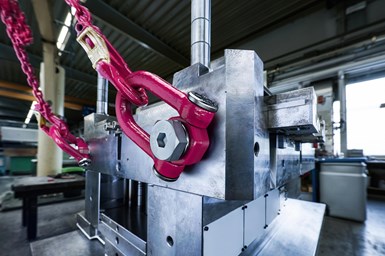Intelligent Lifting Point Achieves Greater Load Weights
RUD ACP-TURNADO bolt diameters are offered in a range of new sizes for load weights up to 16 tons, expanding its application range.

All photo credit: RUD
Lifting and lashing technology supplier RUD Ketten Rieger & Dietz GmbH u. Co. KG has launched new variants of the RUD ACP-TURNADO to achieve heavier loads up to 16 tons for higher working load limits (WLLs) and expand its application range. The intelligent-centric lifting point automatically rotates in the load direction when the load is lifted, preventing the lift bail from coming to a dangerous standstill and avoiding other associated high shear forces. This eliminates sagging and sudden reversal of the suspension bail, and enables a higher level of safety when handling load, crane and load-handling equipment.
Hermann Kolb, divisional manager of Sling & Lashing Units at RUD says the RUD ACP-TURNADO eliminates two known weaknesses of conventional centric lifting points, regardless of the size variant. For example, if a conventional lifting point’s U-bar stops in the “worst-case position” — when the lifting point is installed 90° from the side — it is exposed to large shear forces and bending moments. This can result in damage or breakage; as soon as the bracket then turns out of this position, the load usually sags.
RUD ACP-TURNADO incorporates a spring mechanism to prevent a 90-degree position of the lift bail, Kolb says, by turning it in the direction of the optimal split force introduction before lifting. Further, the company notes that unlike previous versions, the RUD ACP-TURNADO’s new, larger bolt sizes, come with the spring mechanism located internally, protecting against pollution.

In addition to safety-relevant aspects, the RUD ACP-TURNADO also offers handling advantages. Like the sizes M12 to M30, the large versions have a swivel joint in the U-axis as well as an exchangeable combination head bolt with internal and external hexagon, which enables optimum handling. Moreover, instead of a standard thread length across several sizes, an adapted thread length is available for each dimension. Wear lenses located at critical points of the lift bail are said to make it easy to assess whether the lifting point has already reached discard maturity.
A new feature, the deflector disc, offers an angle marking, to ensure users can estimate the applied lifting angle faster and easier. Additionally, the WLL specification in “t” and “lbs,” the safety factors 4:1 and 5:1 and the torque moment are pressed onto the disc, fulfilling American standard ASME B30.26 requirements.
RUD ACP-TURNADO, previously applicable for moldmaking, tool making, automotive, mechanical engineering, as well as the energy and offshore wind industries, is now qualified for applications where safety, high WLL and the need for improved handling are top priority. New bolt diameters M12 / ½”, M16 / 5/8”, M20 / ¾”, M24 / 1”, M30 / 1 ¼” as well as M36, M42, 1 ½” and 1 ¾” are available; RUD says other sizes from M48 to M100 are to follow shortly. An RFID transponder to simplify equipment checks is also serially installed, a procedure that reportedly reduces inspection costs, times and leads. Lifting operators can choose to manage inspection data and documents in their own databases or use Aye-D.Net software, a cloud-based equipment management tool offered by Syfit, a partner company of RUD.
Related Content
-
How to Maintain Heaters, Thermocouples, Valve Gates and Controls
An examination of real-world problems and solutions involving hot runner system maintenance.
-
How to Use Thermal Management to Improve Mold Cooling
A review of common mold cooling issues and possible solutions, including 3D printing applications.
-
What You Need to Know About Hot Runner Systems and How to Optimize Their Performance
How to make the most out of the hot runner design, function and performance.








_300x250 1.png;maxWidth=300;quality=90)



.png;maxWidth=300;quality=90)



